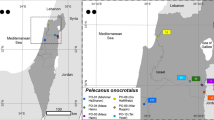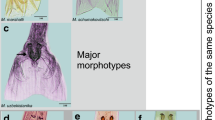Abstract
In several mountainous regions of Northeastern India, foci of Paragonimus infection reportedly involving species that are known to prevail in China have been identified. The present study was undertaken to demonstrate the surface fine topography and sequence analysis of the ribosomal deoxyribonucleic acid (rDNA; second internal transcribed spacer, ITS2) of the metacercarial stages of the lung fluke collected from a mountain stream of the area (Miao, Changlang District in Arunachal Pradesh). The encysted metacercariae were oval in shape and had a smooth surface. The newly excysted metacercaria had a ventral sucker larger than the oral; the body surface was covered with numerous single-pointed and thorn-like tegumentary spines, of which those on the anterior part of the body were bigger in size and showed a gradual reduction in length and number towards the posterior end; dome-shaped papillae in variable numbers were seen around the rim of the oral sucker and were sparsely distributed all over the body surface. The polymerase chain reaction-amplified rDNA ITS2 sequences of the metacercariae were aligned with known sequences for the various species of Paragonimus, and the expectation value was found to be most significant with P. westermani, revealing an absolute match. The surface topography including the number and distribution of papillae and spination patterns and the ITS2 sequences of the metacercariae strongly suggest that the Paragonimus species, prevalent in the region of India, is in fact P. westermani.




Similar content being viewed by others
References
Adlard RD, Barker SC, Blair D, Cribb TH (1993) Comparison of the second internal transcribed spacer (ribosomal DNA) from populations and species of Fasciolidae (Digenea). Int J Parasitol 23:423–425
Aji T, Oh H, Tongu Y, Inatomi S, Hata H, Kobayashi M, Yokogawa M, Miranda H, Ibanz N (1984) Ultrastructure of tegumental surface of the metacercaria of Paragonimus peruvianus. Jpn J Parasitol 33:15–21
Blair D, Campos A, Cummings MP, Laclette JP (1996) Evolutionary biology of parasitic platyhelminths: the role of molecular phylogenetics. Parasitol Today 12:66–71
Blair D, Agatsuma T, Watanobe T, Okamoto M, Ito A (1997) Geographical genetic structure within the human lung fluke, Paragonimus westermani, detected from DNA sequences. Parasitology 115:411–417
Blair D, Xu ZB, Agatsuma T (1999a) Paragonimiasis and the Genus Paragonimus (Review). Adv Parasitol 42:113–222
Blair D, Wu B, Chang ZS, Gong X, Agatsuma T, Zhang YN, Chen SH, Lin JX, Chen MG, Waikagui J, Guevara AG, Feng Z, David GM (1999b) A molecular perspective on the genera Paragonimus Braun, Euparagonimus Chen and Pagumogonimus Chen. J Helminthol 74:295–299
Bowles J, Blair D, McManus DP (1995) A molecular phylogeny of the human schistosomes. Mol Phylogenet Evol 4:103–109
Bunnag D, Harinasuta T (1985) Opisthorchiasis, clonorchiasis and paragonimiasis. In: Warren KS, Mahmoud AAF (eds) Tropical and geographical medicine. McGraw-Hill, New York, pp 461–470
Campbell AJD, Gasser RB, Chilton NB (1994) Differences in a ribosomal DNA sequence of Strongylus species allows identification of single eggs. Int J Parasitol 25:359–365
Chandler AC, Read CP (1961) Introduction to parasitology. Wiley, New York, pp 299–331
Chen HT (1940) Morphological and developmental studies of Paragonimus iloktsuenensis with some remarks on other species of the genus (Trematoda: Troglotrematidae). Lingnan Sci J 19:429–530
Chen HT (1959) The occurrence of a new type of Paragonimus and some clinical problems related to lung fluke in China. 1958 Annual Report. Chung Shang Medical College, China, pp 192–193 (in Chinese)
Chen HT, Hsia TK (1964) A prelimnary report on a new species of Paragonimus. 1. Paragonimus heterotremus sp.nov. Acta Zhongshan Univ 2:236–238 (in Chinese, English abstract)
He YX, Lin YG, Zhong WY (1982) Scanning electron microscopy of Paragonimus skrjabini, a pathogenic lung fluke in china. Acta Zool Sin 28:146–148 (in Chinese, English abstract)
Higo H, Ishii Y (1984) Scanning electron microscopy of the newly excysted juveniles Paragonimus westermani (Kerbert, 1878) Braun, 1899 (parthenogenetic type) and P. miyazakii Kamo, Nishida, Hatsushika and Tominura, 1961. Jpn J Parasitol 33:421–427
Higo H, Ishii Y (1987) Comparative studies on surface ultrastructure of newly excysted metacercariae of Japanese lung flukes. Parasitol Res 73:541–549
Hillis DM, Dixon MT (1991) Ribosomal DNA: molecular evolution and phylogenetic inference. Q Rev Biol 66:411–453
Hoste H, Chilton NB, Gasser RB, Beveridge I (1995) Differences in the second internal transcribed spacer (ribosomal DNA) between five species of Trichostrongylus (Nematoda: Trichostrongylidae). Int J Parasitol 25:75–80
Iwagami M, Lo Y, Su K, Lai PF, Fukushima M, Nakano M, Blair D, Kawashima K, Agatsuma T (2000) Molecular phylogeographic studies on Paragonimus westermani in Asia. J Helminthol 74:315–322
Jiang JX, Xia DG (1993) Scanning electron microscopic observation on the encysted and excysted metacercaria of Paragonimus heterotremus (in Chinese, English abstract). Chin J Parasitol Parasit Dis 11:132–134
Kamo H, Nishida H, Hatsushika R, Tomimura T (1961) On the occurrence of a new lung fluke, Paragonimus miyazakii n. sp. In Japan (Trematoda: Troglotrematidae) (in Japanese). Yonaga Acta Med 5:43–52
Kerbert C (1878) Zur Trematoden-Kenntnis. Zool Anz 1:271–273
Kostadinova A, Herniou EA, Barrett J, Littlewood DT (2003) Phylogenetic relationships of Echinostoma rudolphi, 1809 (Digenea: Echinostomatidae) and related genera re-assessed via DNA and morphological analysis. Syst Parasitol 54:159–176
Kusner DJ, King CH (1993) Cerebral paragonimiasis. Semin Neurol 13:201–208
Leon-Regagnon V, Brooks DR, Perez-Ponce G (1999) Differentiation of Mexican species of Haematoloechus Looss, 1899 (Digenea: Plagiorchiformes): molecular and morphological evidence. J Parasitol 85:935–946
Li GY, Zhan XM, Liang JM (1987) Scanning electron microscopy of Paragonimus hueitungensis and Paragonimus bangkokensis (in Chinese). Annu Bull Soc Parasitol Guangdong Prov 8–9:113–114
Miyazaki I (1939) A new lung fluke Paragonimus ohirai n. sp.. Fukuoka Acta Med 32:1247–1252 (in Japanese, German abstract)
Miyazaki I (1974) Lung flukes in the world. Morphology and life history. In: Sasa M (ed) A symposium on epidemiology of parasitic diseases. International Medicine Foundation of Japan, Tokyo, pp 101–135
Miyazaki I (1978) Two types of lung fluke, which has been called Paragonimus westermani (Kerbert, 1878). Med Bull Fukuoka Univ 5:251–263
Miyazaki I, Ishii Y (1968) Studies on the Mexican lung fluke, with special reference to a description of Paragonimus mexicanus sp.nov. (Trematoda: Troglotrematidae). . Jpn J Parasitol 17:445–453
Morgan JAT, Blair D (1995) Nuclear rDNA ITS sequence variation in the trematode genus Echinostoma: an aid to establishing relationships within the 37-collar spine group. Parasitology 111:609–615
Narain K, Devi KR, Mahanta J (2003) Paragonimus. and paragonimiasis—a new focus in Arunachal Pradesh, India. Curr Sci 84:985–987
Razaque MA, Mutum SS, Singh TS (1991) Recurrent haemoptysis? Think of paragonimiasis. Trop Doct 21:153–155
Roy B, Tandon V (1991) Usefulness of Tetramethylsilane in the preparation of helminth parasites for scanning electron microscopy. Riv Parassitol 8:405–413
Samson-Himmelstjerna GV, Woidtke S, Epe C, Schnieder T (1997) Species- specific polymerase chain reaction for the differentiation of larvae from Dictyocaulus viviparus and Dictyocaulus eckerti. Vet Parasitol 68:119–126
Scholz T, Skerikova A, Shimazu T, Grygier MJ (2004) A taxonomic study of species of Bothriocephalus Rudolphi, 1808 (Cestoda: Pseudophyllidea) from eels in Japan: morphological and molecular evidence for the occurrence of B. claviceps (Goeze, 1782) and confirmation of the validity of B. japonicus Yamaguti, 1934. Syst Parasitol 57:87–96
Singh TS (2002) Occurrence of the lung fluke Paragonimus hueitungensis in Manipur, India. Zhonghua Yi Xue Za Zhi (Taipei) 65:426–429
Singh TS, Mutum S, Razaque MA, Singh YI, Singh EY (1993) Paragonimiasis in Manipur. Indian J Med Res 97:247–252
Sugiyama H, Horiuchi T, Tomimura T, Shibahara T, Agatsuma T, Habe S, Ketudat P, Thaithong S (1990) Surface ultrastructure of newly excysted metacercariae of Paragonimus heterotremus. South Asian J Trop Med Public Health 21:109–113
Sugiyama H et al (2001) Surface ultrastructure of newly encysted metacercaria of Paragonimus westermani from Malaysia and the Philippines. Jpn J Trop Med Hyg 29:375–378
Sugiyama H, Morishima Y, Kameoka Y, Kawanaka M (2002) Polymerase chain reaction (PCR)-based molecular discrimination between Paragonimus westermani and P. miyazakii at the metacercarial stage. Mol Cell Probes 16:231–236
Tkach VV, Pawlowski J, Sharpilo VP (2000) Molecular and morphological differentiation between species of the Plagiorchis vespertilionis group (Digenea, Plagiorchiidae occurring in European bats, with a re-description of P. vespertilionis group (Muller, 1780). Syst Parasitol 47:9–22
Tongu Y, Aji T, Oh H, Ishii A, Yokogawa M, Hata H, Ito J, Lamothe-Argumedo R (1985) Surface ultrastructure of Paragonimus mexicanus Miyazaki et ishii, 1968. Jpn J Parasitol 34:441–447
Tongu Y, Iwanaga Y, Hata H, Tsuji M, Yokogawa M, Morera P, Conejo M (1987) Morphological features of Paragonimus metacercariae from Costa Rica. Jpn J Parasitol 36:236–241
Tongu Y, Hata H, Orido Y, Pinto MR, Lamothe-argumedo R, Yokogawa M, Tsuji M (1995) Morphological observations of Paragonimus mexicanus from Guatemala. Jpn J Parasitol 44:365–370
Toscano C, Yu SH, Nunn P, Mott KE (1995) Paragonimiasis and tuberculosis, diagnostic confusion: a review of the literature. Trop Dis Bull 92:R1–R26
Voelker J, Vogel H (1965) Zwei neue Paragonimus-arten aus West-Afrika: Paragonimus africanus und Paragonimus uterobilateralis (Troglotrematidae: Trematoda). Z Tropenmed Parasitol 16:125–148 (English abstract)
White BA (1993) PCR Protocols, current methods and applications, vol 15. Humana, Totowa, NJ
Acknowledgements
This study was carried out under the ‘All India Co-ordinated Project on Capacity Building in Taxonomy: Research on Helminths,’ sanctioned to VT by Ministry of Environment and Forests, GOI; DBT Project to VT and AC and DSA programme of the University Grants Commission, GOI, in the Department of Zoology, NEHU, Shillong. We thank the co-ordinator, Bioinformatics Centre, NEHU, for allowing access to its facility.
Author information
Authors and Affiliations
Corresponding author
Additional information
The nucleotide sequence data reported in this paper have been submitted to the Genbank data with the accession number DQ351845.
Rights and permissions
About this article
Cite this article
Tandon, V., Prasad, P.K., Chatterjee, A. et al. Surface fine topography and PCR-based determination of metacercaria of Paragonimus sp. from edible crabs in Arunachal Pradesh, Northeast India. Parasitol Res 102, 21–28 (2007). https://doi.org/10.1007/s00436-007-0715-4
Received:
Accepted:
Published:
Issue Date:
DOI: https://doi.org/10.1007/s00436-007-0715-4




